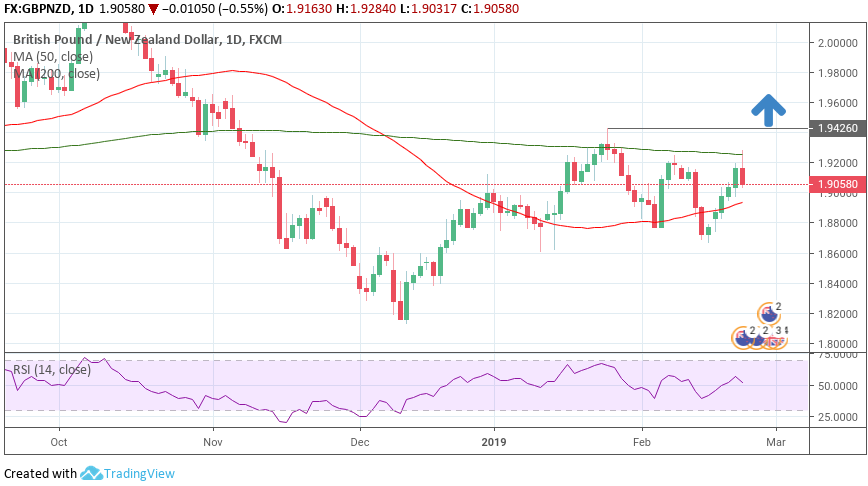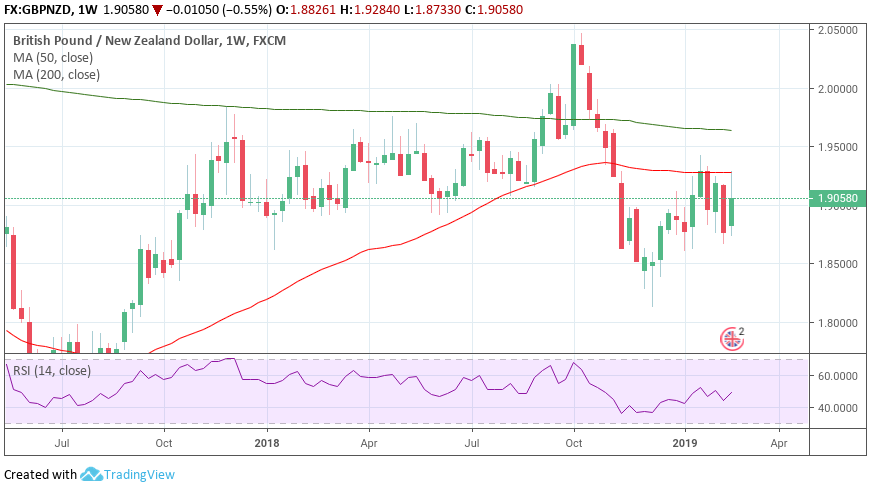The Pound-to-New-Zealand-Dollar Rate in the Week Ahead: Mild Uptrend Still Intact

Image © Adobe Stock
- GBP/NZD to rise as uptrend extends in short-term.
- But market must retake Jan high for trend to endure.
- Pound moved by Brexit news; Kiwi by retail sales data.
The Pound-to-New-Zealand-Dollar rate is trading at 1.9058 Monday after closing 1.5% higher last week, and remains on course to challenge the January 25 high, which guards the pathway toward the 200-week moving average located around the 1.98 threshold.
Recent gains for the pair came due to signs Prime Minister Theresa May could have a better chance of getting Brexit deal through Parliament than was previously the thought, and following rumours that a three month deferral of the March 29 Brexit day is increasingly likely, seemingly voiding the possibility of a no-deal Brexit.
The rally may have been enhanced by New Zealand Dollar (Kiwi) weakness that has arisen due to concerns about the outlook for China if the U.S. goes ahead with its promise to raise tariffs from 10% to 25% on March 01.
President Donald Trump said Monday the tariffs won't rise next month but markets didn't know this last week and New Zealand (NZ) does a lot of trade with China so a deteriroation of the latter's economy would also impact negatively on NZ. The deal announced Monday could benefit the Kiwi in the week ahead.

Above: Pound-to-New-Zealand-Dollar rate shown at daily intervals.
From a technical perspective the GBP/NZD pair is trading in wide oscillating waves, within a kind of range, although given the prior trend was up and the last week's run was also higher our bias is to look for further gains. But this is on the condition that the pair can break above the key 1.9426 January 25 high.
Such a break would leave the pair clearly above the 50-week and 200-day moving averages (MA) that had previously been limiting upside for the exchange rate. This would expose the 200-week moving average located at 1.98.
Momentum as measured by the relative-strength-index indicator in the lower pane of the featured charts is a little subdued but not enough to suggest there is a risk of a bearish turn in the market.

Above: Pound-to-New-Zealand-Dollar rate shown at weekly intervals.
The New Zealand Dollar: What to Watch
The most important release for the Kiwi is Q4 retail sales out at 22.45 on the evening of Sunday (24th ie tonight). The metric is is expected (by the ‘market’) to show a 0.5% rise after the flat Q3 result because lower petrol prices will have put more money back in consumer's pockets.
“The sharp falls in petrol prices through November and December will have put money back into households’ wallets. Combined with the earlier increase in government transfer payments to households, we expect to see a 0.7% rise in volumes, underpinned by a solid lift in core (ex-fuel) categories,” says Westpac in its data preview.
Another key release is ANZ bank's business confidence survey in February, which is forecast to show a rise in the balance to +28 from -24.1 previously. Sentiment indicators are often useful leading indicators for the real economy.
“Concern about the downside risks to growth posed by very weak business confidence have eased in recent months as confidence has improved and the economy has trundled along. However, confidence still remains at historically low levels and out of step with the pace of growth we’re seeing in the economy,” says Westpac.
The New Zealand Dollar may also be influenced by what happens between Australia and China given its close links with both these large neighbours.
Last week China banned Australian coal imports into 5 of its ports, some say as a tit-for-tat for Australia’s cancellation of a contract to allow Huawei to install 5G networks, for fear they could be used by the Chinese state for the purposes of espionage.
A deeper dislocation between the two countries would hot the whole region, including NZ and the Kiwi would almost certainly suffer as a result.
Likewise if the ports were to reopen following a diplomatic compromise of some sort, the Kiwi would also probably rise back higher on the news. Overall we remain optimistic a compromise will be sought and a worsening diplomatic crisis be averted.
The Pound: What to Watch this Week
Brexit focus returns to Westminster this week with the Prime Minister due to make a statement in Parliament on Tuesday and an amendable motion on Brexit is up for debate on Wednesday.
The amendment to look out for is the Cooper/Letwin amendment which if passed (and a linked Bill adopted), would result in the government being directed to request an extension to the Article 50 process, should it not get a deal through Parliament by 13 March.
For Sterling such a bill makes a 'no deal' Brexit less likely on March 29, and therefore its passage would be seen as a positive for the currency.
However, a similar amendment by Cooper failed in January so parliamentarians might still be erring on the side of allowing May the freedom to get concessions from the EU before voting for such an amendment.
Last week Chancellor of the Exchequer Philip Hammond said there was the chance the second, and final, Meaningful Vote on the deal itself might actually take place this week; for this to happen some kind of concessions will need to have been secured from Brussels.
Indeed, it looks like these concessions won't be forthcoming in time for a vote this week and May has told journalists during a flight to a summit in Egypt on Sunday that she intends to hold a Meaningful Vote on the deal by March 12, just 17 days before Brexit.
“If the prime minister, Theresa May, manages to secure legal assurances from the EU on the Irish backstop, there will likely be a meaningful vote on the revised deal. But if UK-EU negotiations have not been completed by then, MPs could simply vote on an amendable motion on how to proceed next with Brexit. The latter carries the risk of Parliament voting to take control of the Brexit process, possibly forcing the government to extend Article 50, if Mrs. May has nothing to show from the latest round of talks with Brussels. Either way, the pound appears to be headed for more volatility.” Says Raffi Boyadjian, a currency analyst at XM.com.
Another key release for the UK currency, is the IHS Markit Manufacturing PMI for February, which is a survey-based activity indicator. This is out at 10.30 GMT on Friday and is forecast to show a drop to 52.0 from 52.8 in the previous month of January. PMI's are important leading indicators for the economy.
The Gfk Consumer Confidence survey is out at 1.01 early on Thursday morning and is forecast to show a -15 result from -14 previously - mainly as the mood sours over Brexit. An even sharper-than-predicted fall in the Gfk could well have negative repercussions for Sterling since declines in sentiment indicators often precede falls in the real economy.
Time to move your money? Get 3-5% more currency than your bank would offer by using the services of foreign exchange specialists at RationalFX. A specialist broker can deliver you an exchange rate closer to the real market rate, thereby saving you substantial quantities of currency. Find out more here.
* Advertisement




